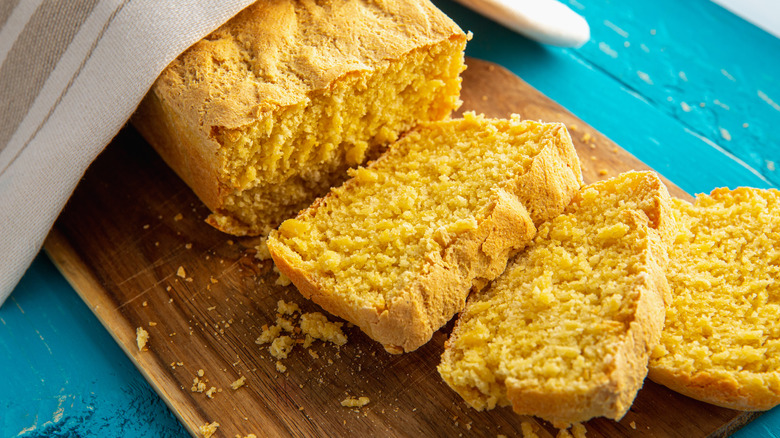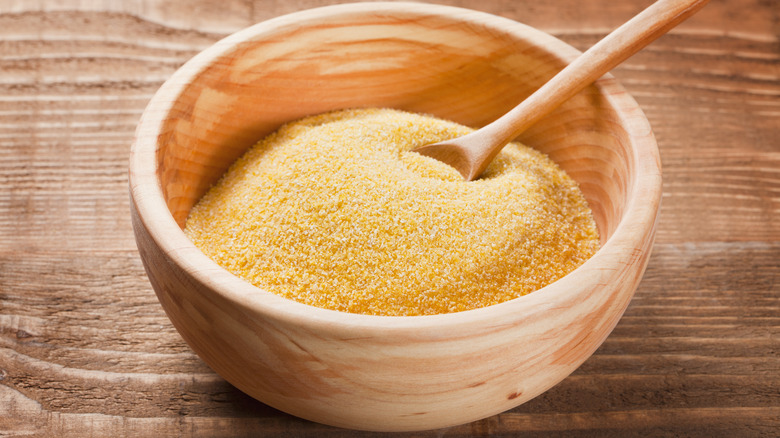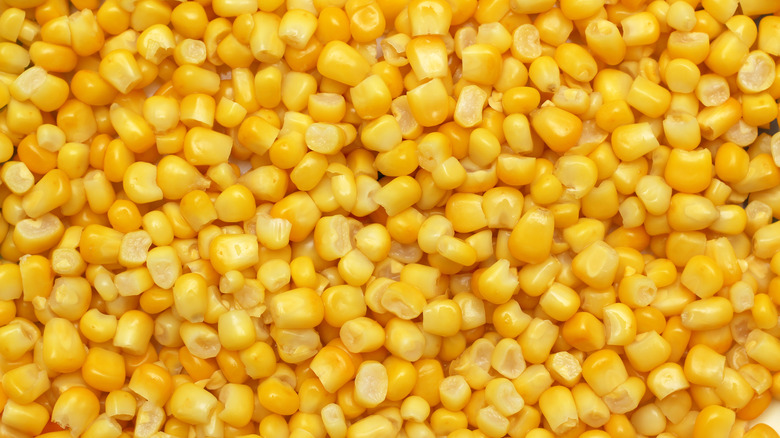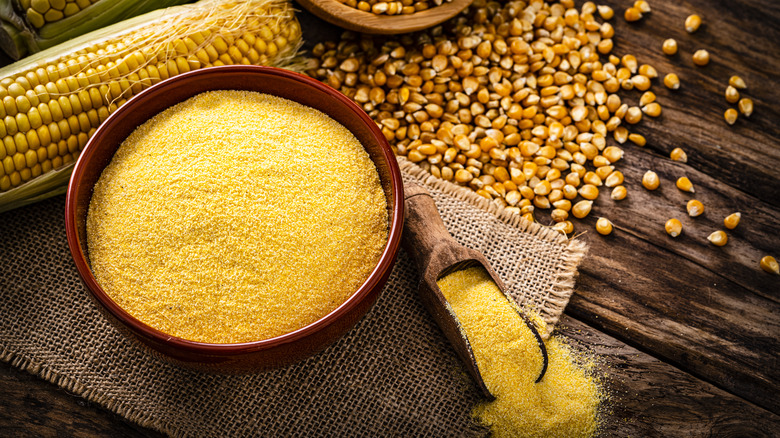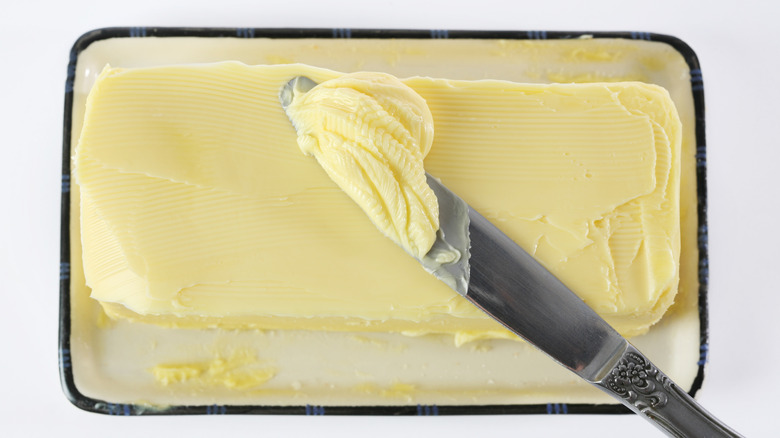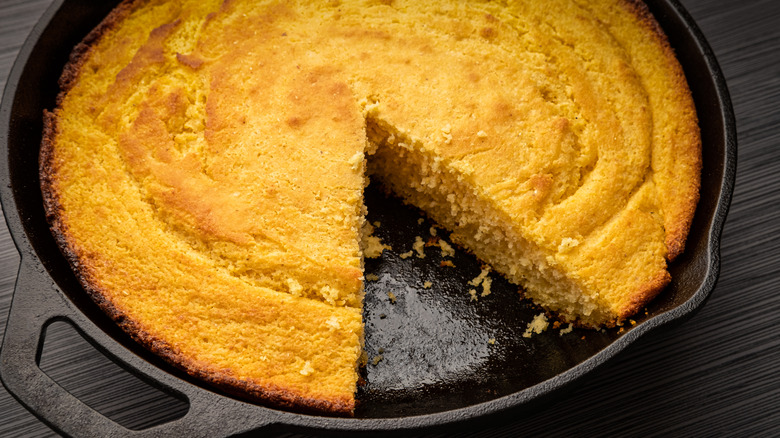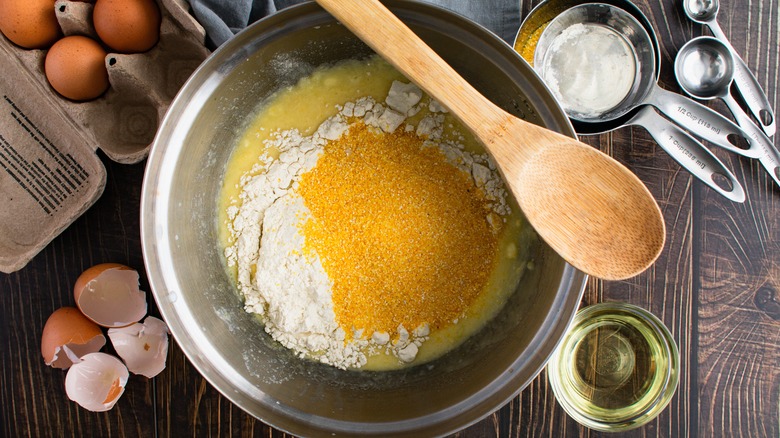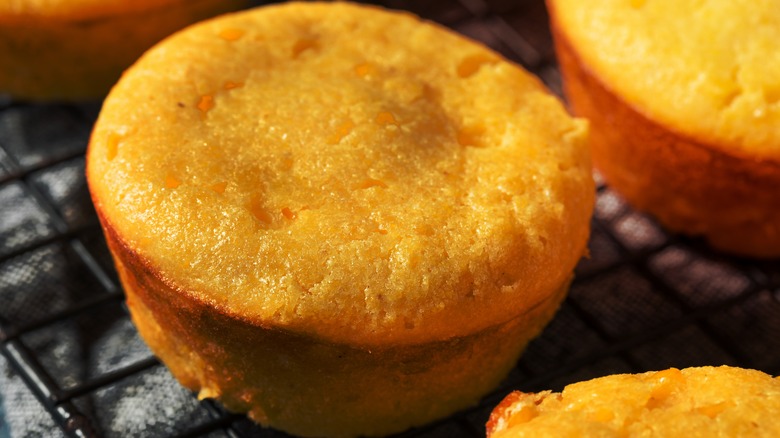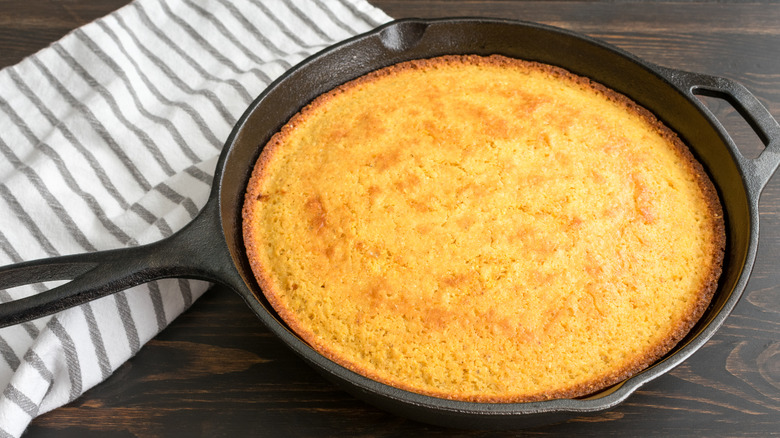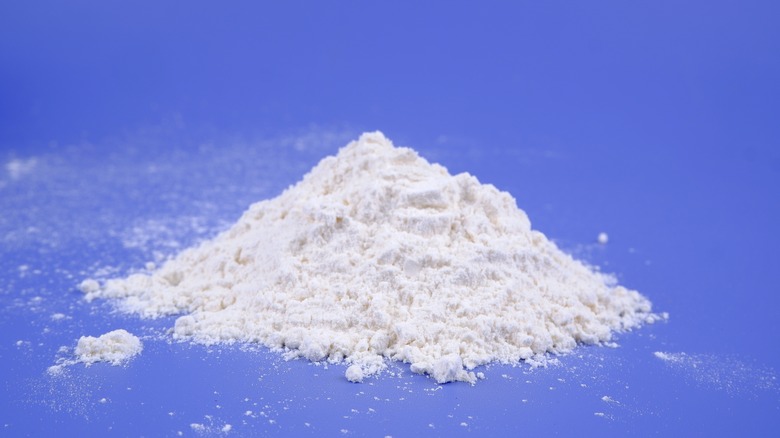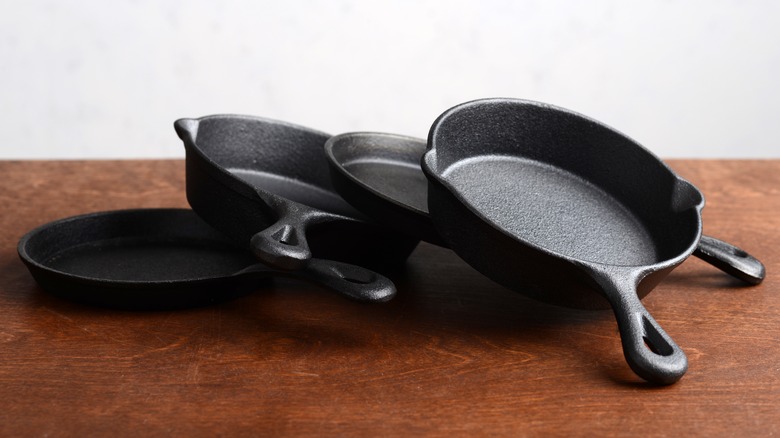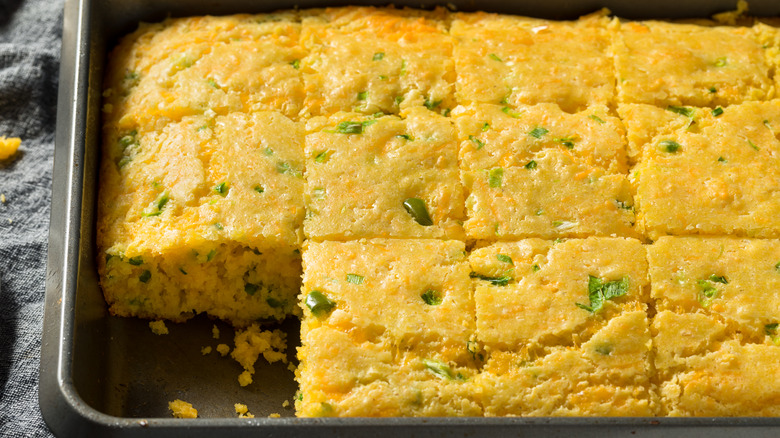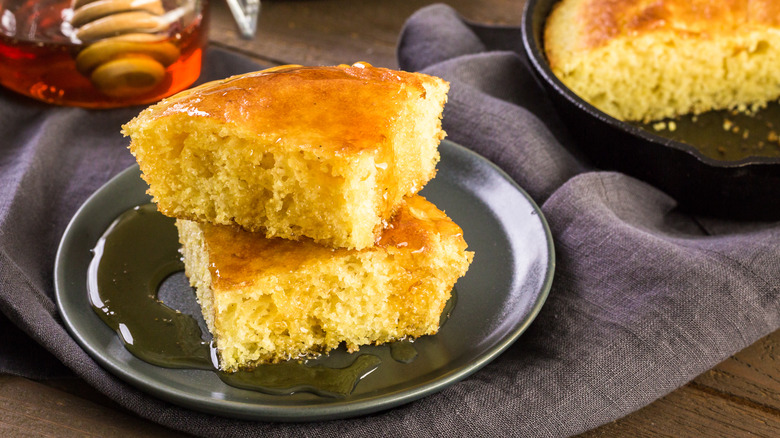14 Common Mistakes To Avoid When Making Cornbread
When you think of bread today, most people think of a loaf made of wheat — but that wasn't always the case. Cornbread was the dominant form of bread for much of America's history, thanks to corn's wide availability and the relative lack of availability of wheat. While regular white loaves have today become many people's go-to carb choice, cornbread has remained highly popular, especially in Southern states, where it's often served as an accompaniment to meat dishes or as an ingredient in holiday favorites like cornbread dressing.
As cornbread recipes have evolved over centuries, they've often relied on hand-me-down knowledge and tips shared by home chefs with their loved ones. However, not everyone has had the benefit of a beloved grandma sharing their wisdom and watching over them while they cook, leading to a host of potential errors when they're making it.
Cornbread can be prone to a few danger zones when being cooked, including becoming too dry and mealy or else ending up flat and airless. It can also taste surprisingly flat if you don't get your balance of flavors just right or forget to include some key additions. Luckily, we've got all those mistakes covered right here, as well as how to fix them.
1. Using the wrong cornmeal for your cornbread style
Like many traditional foods, cornbread is rarely made in just one way, and over time, several different styles have developed. Arguably, the two main styles, though, are white and yellow cornbread, which are typical to certain parts of the country and are always made with specific types of cornmeal.
"Southern cornbread is made with white corn meal, which means it's made from white corn," says Martha White Foods' director of consumer affairs and test kitchens Linda Carman, per Deseret News. "Yellow corn meal comes from yellow corn... I grew up in Cullman, Alabama, and I never ate any yellow cornbread."
As such, opting to use yellow cornmeal in a Southern recipe means that you'll end up with a cornbread that isn't very authentic. Importantly, both white and yellow cornmeal are interchangeable, and opting for one or the other likely won't make any significant difference.
However, they do have a slightly distinct taste, with yellow corn tasting a bit more corn-like and white corn having a more delicate flavor. The main reason you should always stick to the cornmeal your recipe dictates, though, is because using a different type will leave you with a cornbread that doesn't align with the traditions that have been handed down from generation to generation, a key factor in its enjoyment.
2. Forgetting to vary its texture with fresh corn
Like other types of bread, cornbread's texture can be altered far beyond its regular doughy consistency. However, far few people choose to do so; instead, they just stick with a standard blend of cornmeal and wheat and not much more. While this can give you a reliable result, it can also leave you with a cornbread that's dense and frankly a little boring.
You can make an easy alteration, though, by using fresh corn in your cornbread batter. All you need to do is take around a half cup of canned corn and throw it into your mixture. Doing this achieves a few key functions.
The first is that it gives your cornbread a chunkier consistency, making each bite more interesting. The addition of fresh corn also gives the batter more moisture, which will prevent it from drying out. In addition to this, the cornbread also takes on a slightly richer taste, with the corn giving it an injection of fresh corn flavor. While you can do this when making homemade cornbread from scratch, this trick is particularly useful when using a boxed mixture as a way to add quick, easy flavor.
3. Choosing the wrong grind size for your cornmeal
Cornbread amateurs and pros alike can often make the mistake of picking the wrong grind for their bake. The product comes in a variety of grind sizes, from a slightly gritter coarse grind to a way finer consistency. The grind you pick will ultimately determine how your cornbread turns out, with coarser sizes giving it more bite and a sometimes crunchy texture – and if you opt for the wrong grind, you may end up with a texture that you didn't want or don't like.
As such, remember that the general rule of thumb is that the finer the grind, the softer your texture will be. You may want to pick a fine grind if you're making items that are more cake-like, like classic pancakes or blueberry muffins. For a classic Southern-style cornbread, go for a medium grind, which will provide a soft cohesiveness to the finished product while also giving it some interesting textural variations. Remember as well that you can always combine different grind sizes to customize the texture of your cornbread. Mixing fine and medium grinds, for example, will provide a light chew, while being loose enough to remain tender.
4. Overmixing your batter
If you're whipping your cornbread batter like there's no tomorrow, now is the time to stop. Overmixing your cornbread batter is a surefire way to make it dense and tough. When you mix your batter too much, you introduce a larger amount of air into it, which then gets trapped inside. This creates "tunnels" or little air pockets that have the opposite effect of making your cornbread lighter, and instead cause it to get overly chewy and heavy. Overmixing cornbread batter may also result in the top cracking and peaks forming over its surface.
You should stop mixing your batter far earlier than you think, stopping when everything's just combined. If your batter is still lumpy when you pour it into the pan, that's a good thing. Having lumps in your mixture means that it hasn't been overmixed, which also means that it hasn't developed too much gluten, contributing to its chewiness. Remember, though, that while a little lumpiness is a good thing, you should avoid having any visible streaks of dry ingredients. This will cause your cornbread to end up dry and chalky in parts.
5. Trying to make it without enough fat
Cornbread doesn't usually taste or feel too fatty, but that shouldn't lead you to believe that you don't need any. You probably need to add a little more than you think to keep it moist. Fat introduces lubrication into the cornbread batter without increasing its water content. As a result, the bread will hold its shape better and be softer to bite through.
In addition to this, adding enough fat to cornbread gives it a better flavor and makes everything taste richer and more satisfying. As for what type of fat you use, the world's your oyster. Many people use milk and butter in their cornbread recipes, which gives the bread a dairy-infused flavor.
Buttermilk is also a common choice and helps to imbue the mixture with a touch of sourness, balancing out the slightly sweet flavors of the dish. For a stronger hit of fat, add in a few glugs of oil, or you can even add in some shortening, margarine, or lard. Just make sure not to overdo it, as adding too much fat will make your cornbread feel greasy and weighed down and may affect how it bakes.
6. Beginning with a cold pan
The satisfying sizzle of cornbread hitting a hot pan is a sound that many people know — and many people don't. For the latter, who make their cornbread starting with a cold pan, they're missing out on some vital taste and textural advantages. When you pour the cornbread batter into a preheated pan, its bottom layer begins to cook immediately. This creates a lovely, crispy bottom for the bread's bottom and sides, and introduces a nutty, toasty flavor dimension.
Using a hot pan to cook cornbread also stops it from sticking to the bottom, which then makes it easier to remove and serve the bread. To preheat your pan, stick it in the bottom of a hot oven while you prepare the rest of your ingredients. Ensure that you add plenty of fat into the pan, to give your cornbread the best chance of crisping and to stop it from sticking. Keep in mind the smoke point of the fat you're using, though. If you put a low smoke point fat like butter into an oven that's too hot, you'll end up with a kitchen that's full of acrid fumes, and cornbread that tastes burnt and nasty.
7. Forgetting to skip the soaking stage
Making cornbread may be fairly simple, but if you want the best result, it's likely not as quick as you think — especially if you're working with a coarsely ground cornmeal. Way too many people forget that coarse cornmeal benefits from being soaked for a few hours before you mix it with the rest of your dry ingredients. When you soak your cornmeal, you help to tenderize each grain, and this means that your eventual cornbread will be way more tender and delicious.
It's worth remembering that you don't have to soak your cornmeal, and doing so is entirely optional, particularly if you're working with a finer grind that may tenderize quicker. Skipping it, however, will usually leave you with a tougher cornbread.
It's best to use buttermilk or milk to soak it. Using water will also work, but it may dilute the flavor of your mixture. If you have the time, soaking your cornmeal overnight will give it an even more tender bite, but even giving it ten minutes or so to soak before you cook it will make things softer and more pleasant to eat.
8. Overcooking your cornbread
Baked goods are notoriously difficult to get just right, and cornbread is no different. Because people get worried that their cornbread won't be entirely cooked through, this can lead to them cooking it for longer than necessary, resulting in a dish that's overcooked and dry.
This is made even more complicated by the fact that cornbread is usually cooked in a heavy-duty pan that retains heat effectively. As a result, it will continue to cook when you pull it out of the oven, meaning that even a perfectly timed cornbread may end up overdone.
The solution is simple: Grab a toothpick. By sticking a toothpick into the middle of the cornbread, you can assess how done it is without slicing it open prematurely. If, when you pull your toothpick out, there's a small amount of batter sticking to it, that's usually a good thing.
Taking it out of the oven at this point will allow the rest of it to cook through gently. You should remember, too, that your oven's temperature may not be as accurate as you think, and the true heat may be lower or higher than you set it to. To counteract this, grab a separate infrared thermometer to test its temperature instantly, aiming it at the walls of your oven to do so.
9. Not leaving your batter to rest
Some baked goods benefit from being cooked as soon as the batter is mixed — but cornbread isn't one of them. While many people pour their cornbread mixture straight into the pan to cook, this common mistake can leave your cornbread flat and airless.
Cornbread mixtures include baking powder, and this baking powder acts as a leavening agent to give the batter extra aeration. If you cook it before the baking powder has had time to activate, your cornbread will be too dense.
Importantly, however, how long you leave it is a fine balance, and you should avoid giving it too much time. If you over-rest your batter, your baking powder won't have the desired effect, and you may have a cornbread with a strange texture.
As a general rule of thumb, cornbread will only require about 10 minutes or so to rest before cooking. While you can leave it slightly longer, avoid going over 20 minutes. You can use the time that your cornbread mixture is resting to clean up your kitchen or start heating your pan so that it's ready to receive the batter.
10. Trying to make cornbread without flour
Cornbread is made of corn, right? Well, yes and no. While cornmeal is, of course, a key ingredient in the bread, you'll also likely want to include regular wheat flour to bring everything together. Flour gives your cornbread body and holds everything together nicely due to its high gluten content.
The result is a cornbread that's not only more cohesive but one that feels and tastes lighter. Flour also keeps your cornbread moist as it cooks and stops it from being crumbly. Importantly, using flour isn't a hard and fast rule. You can certainly make cornbread without using flour, and some traditional recipes omit it entirely.
Keeping flour out of your cornbread also keeps it gluten-free, which may be beneficial for folks with certain dietary requirements. Bear in mind, though, that skipping flour will leave you with a cornbread that isn't as well integrated and which will fall apart way easier as you're eating it. Avoiding flour can also leave you with a cornbread that isn't as moist, although you can counteract this by soaking it in milk or buttermilk for longer before you combine it with the rest of your ingredients.
11. Using the wrong pan
When making cornbread, the pan you choose is crucial, and a lot of people use the wrong type. While you can technically use any pan you like for cornbread, few will hit the spot like a cast iron skillet. This classic choice is preferred by many for its ability to distribute and retain heat evenly, as well as its oven-safe nature. Its heating capabilities mean that your cornbread develops a well-browned, crispy surface and a superlative flavor.
You should always ensure that your cast-iron skillet is well-seasoned before using it for cornbread, as this prevents it from sticking to its surface. Seasoning a cast-iron skillet also helps to keep the pan in good condition and extend its lifespan.
If you don't have a cast-iron skillet, you can also use one made from stainless steel, a material that heats up efficiently and helps develop its outer coating. Cake or muffin tins can also be used to make cornbread, but just pay attention to what material they're made from and try to opt for cast iron or stainless steel wherever possible for the best results.
12. Loading it up with sugar
For many people, cornbread is at its best when it's slightly sweet. It's all too easy to overdo it, though. Adding in too much sugar is a seasoning mistake that will turn your cornbread from a neutral yet tasty side dish to something more cake-like, and this can hinder the versatility of the bread and get in the way of its delicate flavor profile.
Overly sugary cornbread can be a particular issue when using boxed mixtures, which often come with high amounts of sugar. Adding more on top of that, which is easily done if you're not paying close attention to your ingredients list or being a bit too liberal with your measures, will make a dish that's too sweet. It's also worth bearing in mind that while sweet cornbread is okay in some applications, in others (like when making cornbread dressing), it can seriously mess up your dish.
You may find that you have to overcompensate by adding in extra amounts of salt to balance things, and this then leaves you with something too overpowering. It's always better to err on the side of caution with both sugar and salt.
13. Skipping adding extra flavors
Although cornbread's base flavor is pretty gentle, that doesn't mean that you should be being unadventurous. Like wheat bread, cornbread can be jazzed up in loads of different ways, with various additions like spices, herbs, and cheeses creating a side dish that's an event in its own right.
One of the easiest ways to give your cornbread a kick is by adding in some jalapeños, finely mincing them so they distribute through the batter evenly, giving every bite a smokey kick. If you don't have fresh jalapeños, you can also introduce spice with a few dashes of chili powder or cayenne pepper.
Throwing in some fresh chopped herbs is a great way to give your cornbread a lighter, more floral edge. Parsley, chives, and thyme are all great additions that usually work well with your main dish, and cilantro can also give your cornbread a slightly peppery dimension.
Dried herbs can also give your cornbread some extra freshness, but just be wary of being too liberal with your additions, as they can overpower its flavor easily. For an instant burst of umami and an added feeling of indulgence, you can also mix some grated cheese into your batter, with cheddar, pepper jack, and Colby cheese all great choices.
14. Not allowing it to cool before serving
It's entirely natural for you to want to dig into your cornbread as soon as it comes out of your oven, but doing so is a grave error. On the contrary, you should always allow it to cool slightly before you dig in.
Giving your cornbread time to cool produces a fluffier overall texture, as the now-cooked batter has time to relax. It also helps that you're not biting into piping-hot bread, which is not only an unpleasant and potentially painful experience but is also a surefire way to dull the taste of your food.
The good news, though, is that you don't have to wait forever. Even five minutes or so will take the edge off the heat of your cornbread and allow it to settle slightly. We would, however, encourage you to wait slightly longer and give your cornbread about 20 minutes to cool before slicing and serving. Cornbread retains its heat pretty well, so you don't have to worry about it becoming cold at this time, and serving it in the pan you cooked it in will also help it stay warm, moist, and delicious.
